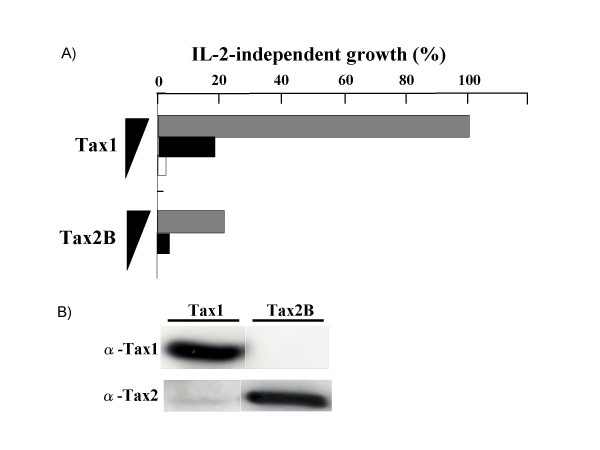Figure 1.
Tax2 induces the IL-2-independent growth of CTLL-2 cells. (A) tax1 and tax2B cDNAs were cloned into the lentivirus vector CSIIEF-RfA which has an elongation factor gene promoter for protein expression in mammalian cells. Lentiviruses encoding Tax1 and Tax2B were produced by the three plasmid cotransfection method in 293T cells derived from an embryo kidney. These lentiviruses were transduced to CTLL-2 cells (4 × 105) in a final volume of 2.0 ml RPMI1640 containing 10% fetal bovine serum (RPMI/10%FBS), 8 μg/ml polybrene (Sigma) and 1 nM recombinant human IL-2 (Takeda). At 48 hours after infection, the infected cells were washed twice with phosphate-buffered saline (PBS), and the serially diluted cells (330/well, 1000/well, 10000/well) were cultured in 96 well plate containing RPMI/10%FBS without IL-2. Four weeks later, the number of wells containing outgrowing cells was counted by light microscopy. IL-2-independent growth (%) was calculated as a ratio of the number of positive wells out of 96 wells. (B) Tax2 proteins in transiently lentivirus-infected CTLL-2 cells were undetectable (data not shown). Therefore, a human T-cell line Jurkat was infected with the lentiviruses encoding Tax1 or Tax2, and 48 hr after the infection, the amount of Tax proteins in Jurkat was measured by a Western blotting analysis. The Western blotting assay was carried out as previously described [37]. The antibodies used were anti-Tax1 monoclonal antibody (Taxy7) [38] and anti-Tax2B polyclonal antiserum, kindly provided by Dr. W.W. Hall (University College Dublin) [39],.

